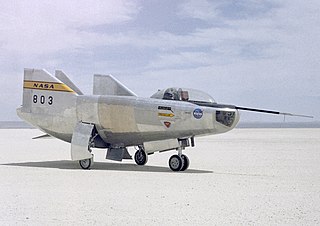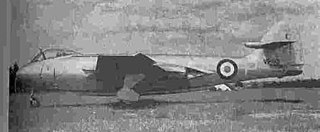
The Bell X-9 Shrike was a prototype surface-to-air, liquid-fueled guided missile designed by Bell Aircraft as a testbed for the nuclear-armed GAM-63 RASCAL. It is named after the shrike, a family of birds.

The Bell X-9 Shrike was a prototype surface-to-air, liquid-fueled guided missile designed by Bell Aircraft as a testbed for the nuclear-armed GAM-63 RASCAL. It is named after the shrike, a family of birds.
Thirty-one X-9 rockets were delivered, flying from April 1949 to January 1953. The program was used to gather aerodynamic and stability data, and to test guidance and propulsion systems for the RASCAL. [1]
None of the missiles survived testing. The only known remaining fragment of an X-9 is part of a vertical stabilizer, at the Larry Bell Museum in Mentone, Indiana. [2]
General characteristics:
Performance:

The Martin Marietta X-24 was an American experimental aircraft developed from a joint United States Air Force-NASA program named PILOT (1963–1975). It was designed and built to test lifting body concepts, experimenting with the concept of unpowered reentry and landing, later used by the Space Shuttle. Originally built as the X-24A, the aircraft was later rebuilt as the X-24B.

The Douglas D-558-2 Skyrocket is a rocket and jet-powered research supersonic aircraft built by the Douglas Aircraft Company for the United States Navy. On 20 November 1953, shortly before the 50th anniversary of powered flight, Scott Crossfield piloted the Skyrocket to Mach 2, or more than 1,290 mph (2076 km/h), the first time an aircraft had exceeded twice the speed of sound.
The Rikugun Ki-202 Shūsui-Kai was a direct development of the German Messerschmitt Me 163 Komet rocket-powered interceptor aircraft. None were produced before Japan's surrender that ended World War II.

The Douglas F5D Skylancer is a development of the F4D Skyray jet fighter for the United States Navy. Starting out as the F4D-2N, an all-weather version of the Skyray, the design was soon modified to take full advantage of the extra thrust of the Pratt & Whitney J57 eventually fitted to the Skyray instead of the Westinghouse J40 originally planned.

The North American X-10 was an unmanned technology demonstrator developed by North American Aviation. It was a subscale reusable design that included many of the design features of the SM-64 Navaho missile. The X-10 was similar to the development of the Bell X-9 Shrike project, which was based on features of the GAM-63 RASCAL.

The Convair XF-92 was an American, delta wing, first-generation jet prototype. Originally conceived as a point-defence interceptor, the design was later used purely for experimental purposes and only one was built. However, it led Convair to use the delta-wing on a number of designs, including the F-102 Delta Dagger, F-106 Delta Dart, B-58 Hustler, the US Navy's F2Y Sea Dart as well as the VTOL FY Pogo.

The Northrop HL-10 was one of five US heavyweight lifting body designs flown at NASA's Flight Research Center in Edwards, California, from July 1966 to November 1975 to study and validate the concept of safely maneuvering and landing a low lift-over-drag vehicle designed for reentry from space. It was a NASA design and was built to evaluate "inverted airfoil" lifting body and delta planform. It currently is on display at the entrance to the Armstrong Flight Research Center at Edwards Air Force Base.

The Northrop M2-F2 was a heavyweight lifting body based on studies at NASA's Ames and Langley research centers and built by the Northrop Corporation in 1966.

The Northrop M2-F3 was a heavyweight lifting body rebuilt from the Northrop M2-F2 after it crashed at the Dryden Flight Research Center in 1967. It was modified with an additional third vertical fin - centered between the tip fins - to improve control characteristics. The "M" refers to "manned" and "F" refers to "flight" version.
The Grumman G-118 was a design for an all-weather missile-armed interceptor aircraft for use on US Navy aircraft carriers. Originally conceived as an uprated F11F Tiger, it soon evolved into a larger and more powerful project. Although two prototypes were ordered in 1955, development was cancelled the same year in favor of the F4H Phantom II before any examples were built. Grumman's next carrier fighter would be the F-14 Tomcat, ordered in 1968.

The Hawker P.1072 was a 1949 experimental British aircraft acting as a test bed for the Armstrong Siddeley Snarler rocket booster engine. It was the prototype Hawker Sea Hawk modified to install the rocket in the tail.

The Lavochkin La-250 "Anakonda" was a high-altitude interceptor aircraft prototype developed in the Soviet Union by the Lavochkin design bureau in the 1950s. Its nickname "Anaconda" was invented during the flight test and referred to both the elongated body shape as well as the relatively critical flight characteristics of the machine.

The Velocity XL is an American amateur-built aircraft, produced by Velocity, Inc. It is an enlarged version of their Velocity SE canard pusher design.

The Bereznyak-Isayev BI-1 was a Soviet short-range rocket-powered interceptor developed during the Second World War.

The Vought XF8U-3 Crusader III was an aircraft developed by Chance Vought as a successor to the successful Vought F-8 Crusader program and as a competitor to the McDonnell Douglas F-4 Phantom II. Though based in spirit on the F8U-1 and F8U-2, and sharing the older aircraft's designation in the old Navy system, the two aircraft shared few parts.

The GAM-63 RASCAL was a supersonic air-to-surface missile that was developed by the Bell Aircraft Company. The RASCAL was the United States Air Force's first nuclear armed standoff missile. The RASCAL was initially designated the ASM-A-2, then re-designated the B-63 in 1951 and finally re-designated the GAM-63 in 1955. The name RASCAL was the acronym for RAdar SCAnning Link, the missile's guidance system. The RASCAL project was cancelled in September 1958.

The Yakovlev Yak-32 was a single-seat version of the Yakovlev Yak-30 (1960), and was claimed by the OKB to be the world's first sporting aircraft with an ejection seat. This version was designated Yak-104PS. Neither the Yak-30 nor the Yak-32 entered production.

The IAR-111 Excelsior was a supersonic mothership project, designed by ARCA Space Corporation, intended to transport a rocket payload up to 18,000 m (59,000 ft) and for developing space tourism related technologies. The aircraft was supposed to be constructed almost entirely from composite materials, and was to be designed for take-off and landing from the sea surface.
The Aquilair Swing is a French ultralight trike that was designed and produced by Aquilair of Theizé. When it was available the aircraft was supplied as a complete ready-to-fly-aircraft.
The Aviolanda AT-21 was a target drone developed in the Netherlands by Aviolanda. Powered by a pulsejet engine, it was the Netherlands' first drone to be successfully developed, and saw limited use in the late 1950s and early 1960s.